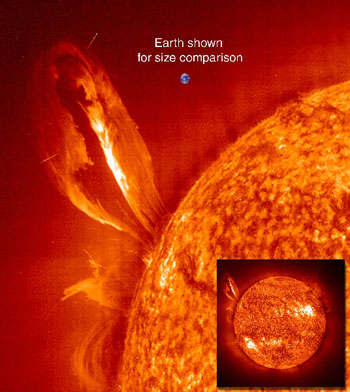|
from TheExaminer Website
On April 8, a front page article was published in the Wall Street Journal on the dangers posed by cyber-spies to the U.S. electrical grid.
According to senior intelligence officers who spoke with the Journal,
No action has been taken so far to disrupt the electrical grid by China, Russia and other involved countries. In a time of war or national crisis, however, the electrical grid could be severely disrupted by foreign entities disrupting the electrical grid through the internet.
Solar activity in 1999. Photo: SOHO
The possibility of cyber-attacks is considered very real by some sources.
Missing entirely from the Wall Street Journal article, however, was any mention of a more likely threat to the electrical grid. A threat that led a prestigious panel of scientists with the National Research Council issuing a report in January 2009 warning of a catastrophic electrical grid failure – giant solar storms around 2012.
They pale into insignificance, however, when compared with the threat posed by massive solar storms bombarding the Earth around 2012 as Solar Cycle 24 peaks. Focusing on possible cyber attacks on the electrical grid is wholly inadequate and even a distraction to the very real threats posed by Solar Cycle 24. Solar storms have been acknowledged by scientists to pose a genuine threat to the U.S. electrical grid.
A
March 23
article by Michael Brooks of The New Scientist, graphically outlined
how millions of American lives would be risk. As we approach 2012, a comprehensive
strategy is urgently needed to deal with large scale disruptions to
the electrical grid for weeks and even months at a time.
A Bill titled The Cyber-security Act of 2009 seeks,
It would be up to the President to
define a “cybersecurity emergency” which among other aspects of the
proposed legislation has already
sparked strong criticism.
Reports are emerging that action has
already been secretly taken to deal with the threats posed by
Solar
Cycle 24.
She wrote:
The engineer and wife decided to remain anonymous. Though the claim is unconfirmed, it is consistent with the 2009 National Science Council report about a major electrical grid failure associated with 2012 and the destruction of transformers world wide.
According to Daniel Baker, chair of the space science committee responsible for the report:
What gives the report even more urgency
is
NASA's announcement on December 16, 2008 of a giant hole in the
Earth's magnetosphere that will allow up to 20 times the normal rate
of solar plasma to enter the Earth.
Massive Solar Storms
from
YouTube Website
A number of non-governmental initiatives are underway to support inventors wanting to develop new energy generators. These include the New Energy Movement, the New Energy Congress and the Orion Project, all of which are privately funded and seeking public assistance.
These private efforts need to be supplemented by a massive federal government investment in new energy technology and infrastructure that makes the current electrical grid system redundant. That is the best safeguard to any widespread threat to the electrical grid system – whether posed by foreign cyber-attack or future solar storms.
Developing a strategy based solely on cyber-attacks on the electrical grid,
|

